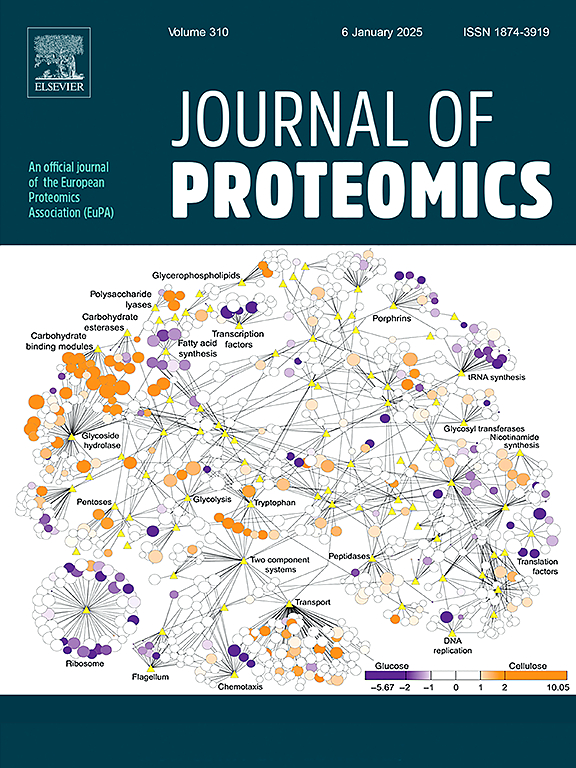Phosphoproteomics revealed salt stress tolerance mechanisms in the roots of sugar beet monomeric addition line M14
IF 2.8
2区 生物学
Q2 BIOCHEMICAL RESEARCH METHODS
引用次数: 0
Abstract
Soil salinity is a major abiotic stress that limits global crop production and food security. It is necessary to explore the mechanisms of salt stress tolerance in order to cultivate high-quality salt-tolerant varieties. Sugar beet M14 line exhibits capability of salt stress tolerance. Here we conducted a phosphoproteomic study of the sugar beet M14 roots treated with 200 mM and 400 mM NaCl. Using phosphopeptide enrichment and LC-MS/MS based phosphoproteomics techniques, 1427 differential abundant phosphoproteins (DAPPs) and 983 unique phosphoproteins were identified under 200 mM NaCl. 1234 DAPPs and 769 unique phosphopeptides were identified under 400 mM NaCl. The two datasets were significantly enriched for terms associated with protein kinases and transcription factors. Meanwhile, the biological pathways enriched between 200 mM and 400 mM NaCl containing signaling pathways, metabolism and transport were prominently represented, suggesting that distinct signaling cascades may converge in key biological processes (e.g., glycolysis, transport and reactive oxygen metabolism) to mediate the salt stress response and tolerance. Furthermore, unlike the DAPPs enriched in sugar beet M14 leaves, the DAPPs enriched in roots specifically participated in the plant-pathogen interaction and prenyltransferase pathways.
Significance: Sugar beet is an important sugar-producing crop, and its roots are the primary organ usually affected by salt stress. However, the phosphoproteomics of sugar beet M14 roots under salt stress remains unclear. This study emphasizes the changes in the phosphorylation level of sugar beet M14 roots proteins under different salt concentrations. We analyzed the similarities and differences in function and participating pathways of the DAPPs and unique phosphoproteins obtained at different salt stresses. These findings not only provide important insights into the mechanisms mediated by phosphorylation modification in sugar beet M14 response to salt stress, but also will inform efforts toward improving crop yield and quality.

磷酸蛋白质组学揭示了甜菜单体添加系M14根系耐盐机制
土壤盐碱化是限制全球作物生产和粮食安全的主要非生物胁迫。为了培育优质耐盐品种,有必要对耐盐机理进行深入研究。甜菜M14品系表现出耐盐胁迫能力。本研究对200 mM和400 mM NaCl处理的甜菜M14根系进行了磷蛋白质组学研究。利用磷酸肽富集和基于LC-MS/MS的磷酸化蛋白质组学技术,在200 mM NaCl下鉴定出1427个差异丰富磷酸化蛋白(DAPPs)和983个独特磷酸化蛋白。在400 mM NaCl下鉴定出1234个DAPPs和769个独特的磷酸肽。这两个数据集显著丰富了与蛋白激酶和转录因子相关的术语。同时,在200 mM ~ 400 mM NaCl之间富集的信号通路、代谢通路和转运通路显著,表明不同的信号级联可能在糖酵解、转运和活性氧代谢等关键生物过程中汇聚,介导盐胁迫响应和耐受。此外,与甜菜M14叶片中富集的DAPPs不同,根中富集的DAPPs专门参与植物-病原体相互作用和戊烯基转移酶途径。意义:甜菜是一种重要的产糖作物,其根系是受盐胁迫影响的主要器官。然而,盐胁迫下甜菜M14根系的磷蛋白组学尚不清楚。本研究着重研究了不同盐浓度下甜菜M14根蛋白磷酸化水平的变化。我们分析了不同盐胁迫下获得的DAPPs和独特磷蛋白在功能和参与途径上的异同。这些发现不仅为了解甜菜M14对盐胁迫的磷酸化修饰介导的机制提供了重要的见解,而且为提高作物产量和质量提供了重要的信息。
本文章由计算机程序翻译,如有差异,请以英文原文为准。
求助全文
约1分钟内获得全文
求助全文
来源期刊

Journal of proteomics
生物-生化研究方法
CiteScore
7.10
自引率
3.00%
发文量
227
审稿时长
73 days
期刊介绍:
Journal of Proteomics is aimed at protein scientists and analytical chemists in the field of proteomics, biomarker discovery, protein analytics, plant proteomics, microbial and animal proteomics, human studies, tissue imaging by mass spectrometry, non-conventional and non-model organism proteomics, and protein bioinformatics. The journal welcomes papers in new and upcoming areas such as metabolomics, genomics, systems biology, toxicogenomics, pharmacoproteomics.
Journal of Proteomics unifies both fundamental scientists and clinicians, and includes translational research. Suggestions for reviews, webinars and thematic issues are welcome.
 求助内容:
求助内容: 应助结果提醒方式:
应助结果提醒方式:


